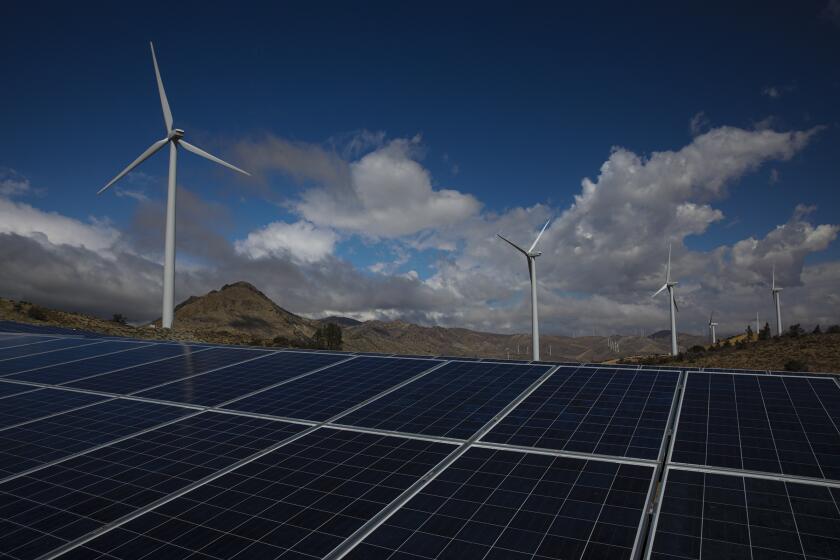
- Share via
Despite its aggressive reputation for cutting greenhouse gas emissions, California releases more of a climate-warming pesticide than all other states combined, most of it from homes fumigated for termites, according to a study published Wednesday.
The termite killing gas — sulfuryl fluoride — has been found to be 4,800 times more potent than carbon dioxide in trapping heat.
When a team of Johns Hopkins scientists set out to map exactly where the gas was being released, they were startled to find that California generated as much as 12% of global emissions of the synthetic fumigant.
“The results were puzzling because the emissions were all coming from one place,” said Scot Miller, Johns Hopkins assistant professor of environmental health and engineering. “Other greenhouse gases like carbon dioxide and methane are found everywhere across the U.S. On our sulfuryl fluoride map, only California lit up like a Christmas tree.”
As much as 85% of U.S. emissions of the chemical come from California, mostly from Los Angeles, Orange and San Diego counties, the scientists found.
Blistering global temperatures have one NASA scientist warning: ‘We could be in uncharted territory.’ Others aren’t so sure.
The chemical’s primary use is the fumigation of homes and other structures, where a building is covered with an airtight tent and gas is pumped in to kill termites and other pests. The brightly colored tents have become a common sight in Southern California neighborhoods.
Within the first two hours of a tent being opened, however, 90% of the gas escapes into the atmosphere, where it stays for about 40 years. (Carbon dioxide, on the other hand, remains in the atmosphere for up to 1,000 years.)
The fumigant is also used to protect grains, nuts and dried fruits from pests after they are harvested.

The new study is not the first time the pesticide has faced scrutiny.
In 2022, environmental groups filed a petition with the state requesting that use of the gas be phased out.
The Center for Biological Diversity and Californians for Pesticide Reform, a coalition of 190 groups, said California was the world’s largest consumer of sulfuryl fluoride, and used 3 million pounds in 2021. The climate impact of using that much of the pesticide, the petition said, was equivalent to the carbon dioxide released from about 1 million vehicles a year.
“Pesticide use in California has a significant, yet overlooked, impact on state greenhouse gas emissions,” the petition said.
The groups’ petition also detailed the dangers to human health of the odorless pesticide, which works by attacking the nervous system. At least 16 deaths have been blamed on sulfuryl fluoride since 1994.
California Department of Public Health scientists detailed in a 2019 report how some families had become ill from what remained of the gas even after the home was cleared for reentry.
Douglas Products, which sells the pesticide under the brand name Vikane, opposed the petition. The company noted that most of the deaths happened after illegal or unauthorized entry into the homes while they were still tented.
The Missouri company, which is owned by private equity firm Brightstar Capital Partners, also said the chemical had a “negligible” impact on climate because it makes up only 0.035% of total greenhouse gas emissions.
The California Air Resources Board denied the environmental groups’ petition in February 2023, saying the agency lacked “sufficient information” to determine whether the pesticide should be phased out. The board said it would continue to study the issue.
California is unlikely to meet its landmark greenhouse gas reduction goals unless it can increase emission reductions threefold, according to a new study.
Use of the gas surged after sales of another fumigant called methyl bromide were sharply curtailed because of the harm it caused to the ozone layer.
In the study published Wednesday, Miller and his colleagues analyzed 15,000 air samples collected between 2015 and 2019 by NOAA Global Monitoring Laboratory scientists. They factored in wind speed, direction and other variables to trace the chemicals to where they were released.
They noted that one caveat of their work was that there are currently no air monitors that would detect the gas in Florida, where the pesticide is also used to control termites.
In an interview, Dylan Gaeta, a doctoral candidate at Johns Hopkins who led the study, said that the climate-warming impact of California’s annual release of sulfuryl fluoride is almost as large as what the state has saved on average annually in greenhouse gas emissions from measures required by AB 32. The 2006 law has lowered emissions through improvements such as vehicles that get better gas mileage, a switch to electric cars and more renewable power.
Gaeta pointed out that pest control companies are already offering alternatives to the gas, including orange oil treatments, that are safer for humans and don’t have the same planet-warming effects.
“For most greenhouse gases, California has been very intentional about how it’s going to reduce emissions,” Gaeta said. “This one has slipped under the radar.”
Toward a more sustainable California
Get Boiling Point, our newsletter exploring climate change, energy and the environment, and become part of the conversation — and the solution.
You may occasionally receive promotional content from the Los Angeles Times.









